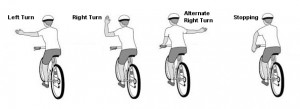The Rules of the Road for Michigan Cyclists
When using the roads, a cyclist is required to follow certain laws intended to ensure that cyclists use reasonable caution and safe cycling practices.
The laws include the following provisions:
- Ride Bike Reasonably Close to the Right Curb
- Riding Bicycles on Sidewalks
- Riding Two (2) Abreast a Bicycle
- Use of Hand Signals While Riding a Bicycle
- Lights When Riding a Bicycle at night
- Riding Double on a Bicycle
- Brakes on a Bicycle
- Riding a Bike While Attached to a Vehicle
- Carrying Packages While Cycling
- Limited Access Highway
- Parking a Bicycle
- Bicycle Helmets and Cell Phones
 Ride Bike Reasonably Close to the Right Curb
Ride Bike Reasonably Close to the Right Curb
If traveling below the normal speed of traffic, a cyclist must ride as close as practicable to the right‑hand curb or edge of the road, except…
If riding your bike below the posted speed limit, a cyclist is required to ride as close as practicable to the right hand curb or edge of the road. (MCL 257.660a) However, this statute recognizes five (5) exceptions or situations where a cyclist need not ride as close to the right hand curb or edge of the road as practicable:
- When passing another bicycle or a vehicle proceeding in the same direction.
- When preparing to turn left.
- When conditions make the right hand edge of the roadway unsafe or unreasonably unsafe for bicycle users, including, but not limited to:
- Surface hazards (i.e., ruts in the pavement or potholes);
- An uneven roadway surface;
- Drain openings;
- Debris;
- Parked or moving vehicles or bicycles;
- Pedestrians;
- Animals;
- Other obstacles; or
- The lane is too narrow to permit a vehicle to safely overtake and pass a bicycle.
- When operating a bicycle in a lane in which traffic is turning right, but the cyclist intends to proceed straight through the intersection; and
- When riding on a one-way highway or street that has two (2) or more lanes. In this situation, the cyclist may also ride as close to the left curb or edge of the roadway as practicable.
Riding Bicycles on Sidewalks
Bicycles may be ridden upon a sidewalk, but cyclists must yield the right-of-way to pedestrians and are required to give an audible signal before overtaking and passing a pedestrian. Further, official traffic control devices or local ordinances may restrict bicycles on sidewalks in some areas. Additionally, a cyclist lawfully operating a bicycle upon a sidewalk or a pedestrian crosswalk has all of the rights and responsibilities applicable to pedestrians using that sidewalk or crosswalk.
(MCL 257.660c)
Riding Two (2) Abreast a Bicycle
Cyclists must not ride more than two (2) bicycles abreast. (MCL 257.660b)
Use of Hand Signals While Riding a Bicycle
A cyclist is required to signal:
- A left turn by extending his/her left hand and arm horizontally.
- A right turn by extending his/her left hand and arm upward, or by extending his/her right hand and arm horizontally.
- A stop or decrease in speed by extending his/her hand and arm downward.
(MCL 257.648)
Lights When Riding a Bicycle at night
If riding one-half hour after sunset, or one-half hour before sunrise, a cyclist must use lights. The law requires that a light system for bicycles must, at a minimum, include a white light which is visible from five hundred (500) feet to the front and a red reflector on the rear which is visible from all distances from one hundred (100) feet to six hundred (600) feet when directly in front of lawful low beam headlights. A lamp emitting a red light visible from a distance of five hundred (500) feet may be used in addition to the red reflector. [MCL 257.662(1)]
Riding Double on a Bicycle
A bicycle may not be used to carry more people than the bicycle is designed and equipped to carry. (MCL 257.658) In other words, riding “double” is prohibited.
Brakes on a Bicycle
A bicycle must be equipped with a brake which enables the operator to make the braked wheels skid on dry, level, clean pavement. [MCL 257.662(2)]
Riding a Bike While Attached to a Vehicle
A cyclist may not attach himself or his bicycle to a streetcar or a vehicle upon a roadway. (MCL 257.659)
Carrying Packages While Cycling
A cyclist may not carry any package that prevents him/her from keeping both hands on the handlebars. (MCL 257.661)
Limited Access Highway
A cyclist may not ride on a limited-access highway. (MCL 257.679a) A limited-access highway is defined as “a highway, street, or roadway in respect to which owners or occupants of abutting lands and other persons have no legal right or access to or from except at such points only, and in such a manner, as made to be determined by the public authority having jurisdiction over such highway, street, or roadway.” (MCL 257.26)
Parking a Bicycle
A bicycle may be parked on a sidewalk, except in places where it is prohibited by an official traffic control device. However, a bicycle may not be parked on a sidewalk in a manner that impedes the lawful movement of pedestrians or other traffic.
Likewise, a bicycle may be parked on a highway or street in any location where parking is allowed for motor vehicles, may park at any angle to the curb or edge of the highway, and may park abreast of another bicycle. However, a bicycle may not be parked on a highway or street in a manner that obstructs the movement of a legally parked motor vehicle. Further, local ordinances may limit the location and manner of bicycle parking. (MCL 257.660d)
Bicycle Helmets and Cell Phones
There is no law that requires Michigan cyclists to wear helmets or prevents them from talking on cell phones while riding. However, it is obviously safe practice to wear a helmet and avoid cell phone use while riding a bicycle.



